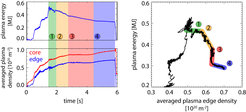Highlights 2013
Research news from the division Plasma Edge and Wall
H-mode density limit, M. Bernert
Nov 2013
H-mode density limit, M. Bernert Nov 2013 Future fusion reactors will most likely be operated in the high confinement mode (H-mode). It is desired to operate these devices at plasma densities as high as possible in order to increase the produced fusion power. However, this is limited by the H-mode density limit.

Classification of the H-mode density limits into 4 phases, here measurements of the energy and density of the plasma
The H-mode density limit was recently studied at the tokamak ASDEX Upgrade at the IPP Garching. Four phases are identified on the approach towards the H-mode density limit, which affect the plasma energy and density differently. These phases are a stable H-mode (green) followed by a degrading H-mode (yellow). The phase of the breakdown of the H-mode (red) finally leads to the L-mode (low confinement mode) (blue). Along with this classification, a new way to explain the H-mode density limit was found. This new description is in line with observations of previous experiments. It involves the coupling of two effects, an increased heat transport at the edge of the plasma and the ionization of the neutral gas outside of the confined plasma.
Experiments at other tokamaks, such as JET, the currently largest tokamak in operation in Culham, UK, are going to be analyzed using this new method in order to make predictions for ITER and other future tokamaks.
With this work Matthias Bernert graduated at the LMU München on the 23rd of October 2013.
http://edoc.ub.uni-muenchen.de/16262/
